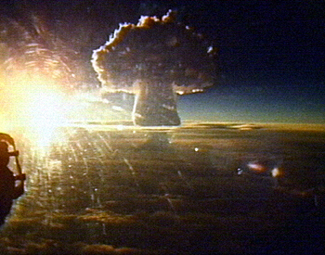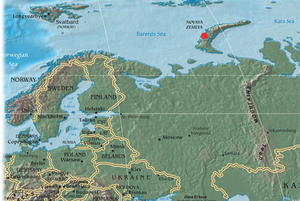Tsar Bomba
From Wikipedia, the free encyclopedia
| RDS-220 | |
|---|---|
 The Tsar Bomba mushroom cloud |
|
| Type | Thermonuclear weapon |
| Place of origin | |
| Production history | |
| Number built | 1 (plus one mock bomb) |
| Specifications | |
| Weight | 27 tonnes |
| Length | 8 meters |
| Diameter | 2 meters |
|
|
|
| Blast yield | 50 megatons |
Tsar Bomba (Russian: Царь-бомба), literally "Tsar-bomb," is the nickname for the RDS-220 hydrogen bomb (codenamed "Ivan" by its developers)—the largest, most powerful nuclear weapon ever detonated.
Developed by the Soviet Union, the bomb was originally designed to have a yield of about 100 megatons of TNT; however that was reduced by half in order to limit the amount of nuclear fallout that would result. One bomb was built and tested on October 30, 1961, in the Novaya Zemlya archipelago.[1] The weapon never entered service; far too expensive for production and offering minimal additional benefit[citation needed] over smaller bombs. It is thought[who?] that its main purpose was a demonstration of the capabilities of the Soviet Union's military technology at that time.
A mock bomb was stored in the Russian Nuclear Weapons Museum in Sarov.
Contents |
[edit] Origins
Soviet General Secretary Nikita Khrushchev initiated the project on July 10, 1961, requesting that the test take place in late October, while the 22nd Congress of the CPSU was in session. Khrushchev approved of the bomb's development during a very tense time; during construction of the first Berlin wall which began on August 13, 1961. Moreover, France had just emerged as the second Western European nuclear force on February 13, 1960 when Gerboise Bleue, the first French nuclear test, was successfully completed.
The Soviets had restarted their tests two months before Tsar Bomba, and there was no de-jure moratorium in place at the time (the U.S. had already announced that it considered itself free to resume testing after further notice).[2]
The term "Tsar Bomba" was coined in an analogy with two other massive Russian objects, the Tsar Kolokol, the world's largest bell, and the Tsar Pushka, the world's largest howitzer. Although the bomb was so named by Western sources, the name is now widely used in Russia.[citation needed]
[edit] Design

The Tsar Bomba was a three-stage hydrogen bomb with a yield of about 50 megatons.[3] This is equivalent to ten times the amount of all the explosives used in World War II combined, including the Little Boy and Fat Man, the bombs that destroyed Hiroshima and Nagasaki.[4] A three-stage H-bomb uses a fission bomb primary to compress a thermonuclear secondary, as in most H-bombs, and then uses energy from the resulting explosion to compress a much larger additional thermonuclear stage. However, there is evidence that the Tsar Bomba had a number of third stages rather than a single very large one.[5]
The initial three stage design was capable of approximately 100 Mt (megatons), but at a cost of too much radioactive fallout. To limit fallout, the third stage, and possibly the second stage, had a lead tamper instead of a uranium-238 fusion tamper (which greatly amplifies the reaction by fissioning uranium atoms with fast neutrons from the fusion reaction). This eliminated fast fission by the fusion-stage neutrons, so that approximately 97% of the total energy resulted from fusion alone (as such, it was one of the "cleanest" nuclear bombs ever created, generating a very low amount of fallout relative to its yield). There was a strong incentive for this modification since most of the fallout from a test of the bomb would fall on populated Soviet territory.[5][6]
The components were designed by a team of physicists which was headed by Academician Julii Borisovich Khariton and included Andrei Sakharov, Victor Adamsky, Yuri Babayev, Yuri Smirnov, and Yuri Trutnev. Shortly after the Tsar Bomba was detonated, Sakharov began speaking out against nuclear weapons, which culminated in him becoming a dissident.[1][6]
[edit] The test

The Tsar Bomba was flown to its test site by a specially modified Tu-95V release plane which took off from an airfield in the Kola peninsula, flown by Major Andrei Durnovtsev. The release plane was accompanied by a Tu-16 observer plane that took air samples and filmed the test. Both aircraft were painted with a special reflective white paint to limit heat damage.
The bomb, weighing 27 tons, was so large (8 metres (26 ft) long by 2 metres (6.6 ft) in diameter) that the Tu-95V had to have its bomb bay doors and fuselage fuel tanks removed. The bomb was attached to an 800 kilogram fall-retardation parachute, which gave the release and observer planes time to fly about 45 kilometres (28 mi) from ground zero.
The Tsar Bomba detonated at 11:32 on October 30, 1961 over the Mityushikha Bay nuclear testing range (Sukhoy Nos Zone C), north of the Arctic Circle on Novaya Zemlya Island in the Arctic Sea. The bomb was dropped from an altitude of 10.5 kilometres (6.5 mi); it was designed to detonate at a height of 4 kilometres (2.5 mi) over the land surface (4.2 kilometres (2.6 mi) over sea level) by barometric sensors.[1][5][6]
The original U.S. estimate of the yield was 57 Mt, but since 1991 all Russian sources have stated its yield as 50 Mt. Khrushchev warned in a filmed speech to the Communist parliament of the existence of a 100 Mt bomb (technically the design was capable of this yield). The fireball touched the ground, reached nearly as high as the altitude of the release plane, and was seen and felt almost 1,000 kilometres (620 mi) from ground zero. The heat from the explosion could have caused third degree burns 100 km (62 miles) away from ground zero. The subsequent mushroom cloud was about 64 kilometres (40 mi) high (nearly seven times higher than Mount Everest) and 40 kilometres (25 mi) wide. The explosion could be seen and felt in Finland, even breaking windows there and in Sweden. Atmospheric focusing caused blast damage up to 1,000 kilometres (620 mi) away. The seismic shock created by the detonation was measurable even on its third passage around the Earth.[7] Its Richter magnitude was about 5 to 5.25.[8] The energy yield was around 7.1 on the Richter scale, but since the bomb was detonated in air than underground, most of the energy was not converted to seismic waves.
Since 50 Mt is 2.1×1017 joules, the average power produced during the entire fission-fusion process, lasting around 39 nanoseconds, was about 5.4×1024 watts or 5.4 yottawatts. This is equivalent to approximately 1.4% of the power output of the Sun.[9]
The Tsar Bomba is the single most physically powerful device ever utilized throughout the history of humanity. By contrast, the largest weapon ever produced by the United States, the now-decommissioned B41, had a predicted maximum yield of 25 Mt, and the largest nuclear device ever tested by the US (Castle Bravo) yielded 15 Mt (due to a runaway reaction; the design yield was approximately 5 Mt).
[edit] Analysis
The weight and size of the Tsar Bomba limited the range and speed of the specially modified bomber carrying it and ruled out its delivery by an ICBM (although on December 24, 1962, a 50 Mt ICBM warhead developed by Chelyabinsk-70 was detonated at 24.2 Mt to reduce fallout).[10] In terms of physical destructiveness, much of its high yield was inefficiently radiated upwards into space. It has been estimated that detonating the original 100 Mt design would have released fallout amounting to about 25 percent of all fallout emitted since the invention of nuclear weapons.[11] Hence, the Tsar Bomba was an impractically powerful weapon. The Soviets decided that such a test blast would create too great a risk of nuclear fallout and a near certainty that the release plane would be unable to reach safety before detonation.[12]
The Tsar Bomba was the culmination of a series of high-yield thermonuclear weapons designed by the USSR and USA during the 1950s (examples include the Mark-17[13] and B41). Such bombs were designed because:
- The nuclear bombs of the day were large and heavy, regardless of yield, and could only be delivered by strategic bombers. Hence yield was subject to dramatic economies of scale;
- It was feared that many bombers would fail to reach their targets because their size and low speed made detection and interception easy. Hence maximizing the firepower carried by any single bomber was considered vital;
- Prior to satellite intelligence, each side lacked precise knowledge of the location of the other's military and industrial facilities;
- A bomb dropped without benefit of advanced inertial navigation systems could easily miss its intended target by six kilometers or more.[citation needed] Parachute retardation would only worsen the bomb's accuracy.
Thus certain bombs were designed to destroy an entire large city even if dropped five to ten kilometers from its centre. This objective meant that yield and effectiveness were positively correlated, at least up to a point. However, the advent of ICBMs accurate to 500 meters or better made such a design philosophy obsolete. Subsequent nuclear weapon design in the 1960s and 1970s focused primarily on increased accuracy, miniaturization, and safety. The standard practice for many years has been to employ multiple smaller warheads (MIRVs) to "carpet" an area. This is believed to result in greater ground damage.[citation needed]
[edit] Documentary
Footage from a Soviet documentary about the bomb is featured in Trinity and Beyond: The Atomic Bomb Movie (Visual Concept Entertainment, 1995), where it is referred to as the Russian monster bomb.[14] The movie incorrectly states that the Tsar Bomba project broke the moratorium on nuclear tests. Soviets restarted their tests two months before Tsar Bomba, and there was no de-jure moratorium in place at the time (the U.S. had already announced that it considered itself free to resume testing without further notice).[2]
[edit] See also
[edit] Notes and References
- ^ a b c Sakharov, Andrei (1990). Memoirs. New York: Alfred A. Knopf. pp. 215–225. ISBN 0-679-73595-X.
- ^ a b Sherman, Robert. "Comprehensive Test Ban Treaty Chronology." Federation of American Scientists, May 30, 2008.
- ^ The yield of the test has been estimated between 50 and 57 megatons by different sources over time. Today all Russian sources use 50 megatons as the official figure. See the section "Was it 50 Megatons or 57?" at "The Tsar Bomba ("King of Bombs")". http://www.nuclearweaponarchive.org/Russia/TsarBomba.html. Retrieved on 2005-01-01-2006.
- ^ DeGroot, Gerard J. The Bomb: A Life. Cambridge, Mass.: Harvard University Press, 2005. p. 254.
- ^ a b c "Tsar Bomba". Nuclear Weapon Archive. http://www.nuclearweaponarchive.org/Russia/TsarBomba.html. Retrieved on 2007-11-03.
- ^ a b c Adamsky, Viktor; Yuri Smirnov (Fall 1994). "Moscow's Biggest Bomb: the 50-Megaton Test of October 1961" (PDF). Cold War International History Project Bulletin (4): 3,19–21. http://www.wilsoncenter.org/topics/pubs/ACF1B7.pdf. Retrieved on 2008-07-21.
- ^ E. Farkas, "Transit of Pressure Waves through New Zealand from the Soviet 50 Megaton Bomb Explosion" Nature 4617 (24 February 1962): 765-766.
- ^ "The Tsar Bomba ("King of Bombs")". http://www.nuclearweaponarchive.org/Russia/TsarBomba.html. Retrieved on 2008-09-08. "Despite being exploded in the atmosphere, it generated substantial seismic signals. According to a bulletin of the U.S. Geological Survey it had seismic magnitude mb = 5.0 to 5.25."
- ^ "The Sun." ircamera.as.arizona.edu, February 15, 2002.
- ^ Atomic Forum; Russian Nuclear Testing Summary
- ^ The Nuclear Weapon Archive: Soviet Nuclear Weapons
- ^ "Tsar Bomba". http://www.atomicforum.org/russia/tsarbomba.html. Retrieved on 2007-11-03.
- ^ GlobalSecurity.org: Mark 17
- ^ "Trinity and Beyond: The Atomic Bomb Movie." Nuclear Weapon Archive, 15 August 1999.
[edit] External links
| Wikimedia Commons has media related to: Tsar Bomba |



